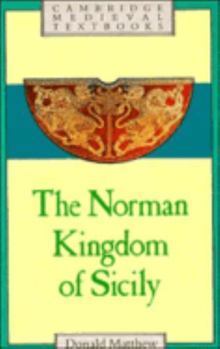The Norman Kingdom of Sicily
(Part of the Cambridge Medieval Textbooks Series)
Select Format
Select Condition 
Book Overview
This book is an introductory account of the kingdom of Sicily established in 1130 by Roger II, a Norman king, and ruled by Roger, his son, and grandsons until 1194 when the kingdom was conquered by his son-in-law, Henry VI of Hohenstaufen. The period covered does, however, extend from 1130 to 1266, when the kingdom passed from the Hohenstaufen heirs to Charles of Anjou, which is roughly as long and as coherent as the Norman monarchy of England between 1066 and 1204.
Format:Paperback
Language:English
ISBN:0521269113
ISBN13:9780521269117
Release Date:July 1992
Publisher:Cambridge University Press
Length:440 Pages
Weight:1.20 lbs.
Dimensions:0.9" x 5.4" x 8.4"
Customer Reviews
3 ratings
Excellent book
Published by Thriftbooks.com User , 15 years ago
This is an excellent book although the proofing of it may have left something to be desired - many spelling errors and some dropped words in the text. I would recommend this book for anyone interested in the historyof Sicily, Southern Italy or the Europe in the late Middle Ages.
Excellent. Did The Renaissance Start Here?
Published by Thriftbooks.com User , 18 years ago
On the whole I agree with the first reviewer on the book in its totality. I found that chapters 1-3,6, and 10-12 were the most informative. The last chapter on the Norman legacy could be a book unto itself. This is a fascinating book on several levels. The author displays great dexterity in showing how this multi-ethnic and multi-religious Kingdom grew, and prospered for decades. The abilities of the Normans and the talents of the very different populations appear to have been largely complimentary. The reader occasionally will ask themselves, "did the Renaissance start here?" Sadly, for the kingdom and perhaps Europe in general? What may have been a tolerant model state could not survive their many external enemies and their own weak leaders after the death of Manfred. I would also recommend Barbara M. Kreutz' "Before The Normans," since it deals with the culture & conditions before the arrival of the Normans. The compare & contrast aspects between the two are good reading for any teacher, student, or history buff.
A synthetic resource
Published by Thriftbooks.com User , 24 years ago
Matthew's history is precise and helpful in arranging the massive amounts of information lying in archives throughout the whole of southern Italy and Sicily. His command of the languages necessary to conducting scholarship in this field is nothing short of extraordinary, and preceisely what Medieval Italian studies needs. His ability to synchronize the material into some navigable whole is easily seen almost every chapter. The only area which seemed a little lackluster was the art and religion chapter. I would have liked to see a little more information regarding the place of Norman art and architecture related to the Byzantine Empire, Venice and the West. However, I haven't run across so detailed a history yet, and will continue to use Matthew's book as a staple reference tool in the future.





